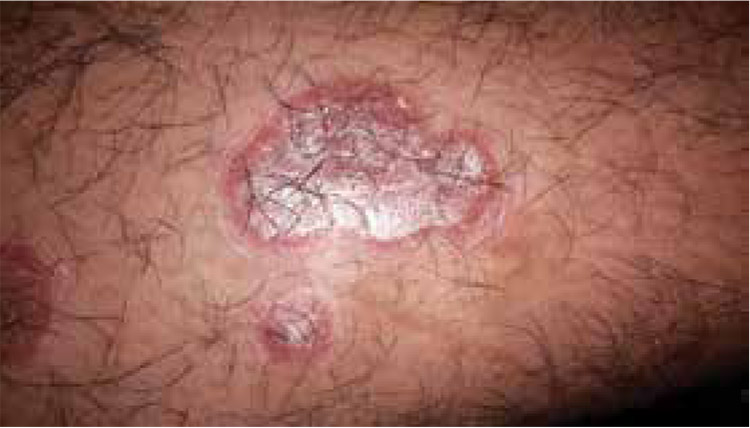Spectrophotometric determination of psoriasis erythema
DOI:
https://doi.org/10.29176/2590843X.280Keywords:
Psoriasis, erythema, reflection spectrophotometryAbstract
Introduction: Psoriasis is an erythematous scaly disease characterized by three physical parameters: erythema, thickness and scaling. Erythema is a determining parameter when evaluating disease activity and may be documented through non-invasive optical techniques. Objective: To measure the grade of erythema in lesions of patients with psoriasis, using diffuse spectrophotometry reflectance. Materials and methods: We carried out a prospective observational quasiexperimental study with an intentional sample of 20 lesions, in varying degrees, of patients diagnosed with psoriasis who consulted the Service of Dermatology, Ciudad Hospitalaria “Dr. Enrique Tejera”, Valencia, Venezuela. For data collection a Hunterlab MiniScan®XE Plus spectrophotometer was used. Results: We observed a direct relationship between the degree of erythema and the slope of the reflectance in the 600-700 nm spectral range. Conclusion: The technique allows to quantify the physical variations of the erythema (color variations), allowing to establish a methodology for the control of psoriasis patients.
Author Biographies
Clara Inés Martínez
Médico, residente de posgrado de Dermatología, Ciudad Hospitalaria “Dr. Enrique Tejera”, Facultad de Ciencias de la Salud, Universidad de Carabobo, Valencia, Venezuela.
Elsa María Pardo
Médico, residente de posgrado de Dermatología, Ciudad Hospitalaria “Dr. Enrique Tejera”, Facultad de Ciencias de la Salud, Universidad de Carabobo, Valencia, Venezuela.
Iriana José Álvarez
Médico, residente de posgrado de Dermatología, Ciudad Hospitalaria “Dr. Enrique Tejera”, Facultad de Ciencias de la Salud, Universidad de Carabobo, Valencia, Venezuela.
Aarón Muñoz
Licenciado en Física, maestría y doctorado en Ciencias Básicas, con especialidad en Óptica; director general, Centro de Investigaciones Médicas y Biotecnológicas de la Universidad de Carabobo, CIMBUC; profesor asociado, Universidad de Carabobo, Valencia, Venezuela.
Sandra Carlina Vivas
Médica dermatóloga; jefe, coordinadora del posgrado de Dermatología, Universidad de Carabobo, Valencia, Venezuela.
References
2. Wippel-Slupetzky K, Stingl G. Future perspectives in the treatment of psoriasis. Curr Probl Dermatol. 2009;38:172-89.
3. Vivas S, Lizama D, Nizar R, Rivas D, Figueredo F. Calidad de vida en pacientes con diagnóstico de psoriasis. Comunidad y Salud. 2012;11:29-34.
4. Fonseca D, Aristizábal L, Cruz C, Herrera L, Prada J, De la Cruz G, et al. Inmunología y terapia biológica en psoriasis. Rev Asoc Colomb Dermatol. 2007;15:208-18.
5. Lewis V, Finlay A. Ten years experiences of the Dermatology Life Quality Index (DLQI). J Investig Dermatol Symp Proc. 2004;9:169-80.
6. Asher B, Pearce D, Lang W, Feldman S. A simplified psoriasis area severity index (SPASI) for rating psoriasis severity in clinic patients. Dermatol Online J. 2004;10:7.
7. Choi JW, Kwon SH, Youn JI, Youn SW. Objective measurements of erythema, elasticity and scale could overcome the inter -and intra -observer variations of subjective. Eur J Dermatol. 2013;23:224-9.
8. van der Kerkhof P. The psoriasis area and severity index and alternative approaches for the assessment of severity: Persisting areas of confusion. Br J Dermatol. 1997;137:661-2.
9. Ashcroft D, Wan Po AL, Williams H, Griffiths C. Clinical measures of disease severity and outcome in psoriasis: A critical appraisal of their quality. Br J Dermatol. 1999;141:185-91.
10. Vivas S, Pardo E, Martínez C, Álvarez I, Muñoz A. Método diagnóstico no invasivo en dermatología: espectrofotometría de reflexión difusa. Informe Médico. 2015;17:49-54.
11. Baranoski GV, Krishnaswamy A. An introduction to light interaction with human skin. RITA. 2004;11:33-62.
12. Everett M, Yeargers E, Sayre R. Penetration of epidermis by ultraviolet rays. Photochem Photobiology. 1966;5:533-7.
13. Anderson R, Parrish J. The optics of human skin. J Invest Dermatol . 1981;77:13-9.
14. Peters VG, Wyman DR, Patterson MS, Frank GL. Optical properties of normal and diseased human breast tissues in the visible and near infrared. Phys Med Biol. 1990;35:1317.
15. Randeberg LL. Diagnostic applications of diffuse reflectance spectroscopy (tesis). Trondheim, Noruega: Norwegian University of Science and Technology; 2005.
16. Bartosova V. Skin effects and UV dosimetry of climate therapy in patients with psoriasis (tesis). Trondheim, Noruega: Norwegian University of Science and Technology; 2010.
17. Kim J, Kim B, Choi J, Kim S, Lee H, Park K, et al. The objective evaluation of the severity of psoriatic scales with desquamation collecting tapes and image analysis. Skin Res Technol. 2012;18:143-50.
How to Cite
Downloads

Downloads
Published
How to Cite
Issue
Section

| Article metrics | |
|---|---|
| Abstract views | |
| Galley vies | |
| PDF Views | |
| HTML views | |
| Other views | |






